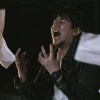
Mamoru Hosoda has made a name for himself as one of the most respected anime directors working today, so why do most of his films lack A-list anime voice actors?
Mamoru Hosoda doesn’t have a new film coming out this summer, but the famed anime director is still very much in the spotlight. Hosoda’s 2015 feature, The Boy and the Beast, is getting international attention for its recent North American theatrical run and English-language home video release, his adaptation of The Girl Who Leapt Through Time is celebrating its 10th anniversary, and there’s even a themed cafe in Tokyo celebrating his works.
The director even stopped by prestigious Waseda University to speak with students as part of a lecture series by cinematic luminaries. While there, he was asked how he goes about choosing voice actors for his films, to which he responded that he prefers actors whose performance draws not so much from technical skills, but from a sense of presence and humanity.
That explanation gels with the more reserved, natural dialogue readings that are often present in Hosoda’s films. Many fans have noticed, though, that there’s something else that differentiates his movies’ vocal casts, in that established anime voice actors almost never play the lead roles in the director’s movies. The core vocal cast for The Boy and the Beast, for example, is made up of Koji Yakusho, Shota Sometani, and Suzu Hirose, all of whom work almost exclusively in live-action film and television. Previous Hosoda hits Wolf Children and Summer Wars are similarly light on big-name anime voice actors.
In this regard, Hosoda’s films have something in common with those of Hayao Miyazaki. While some of the famed Studio Ghibli director’s earlier projects had well-known anime regulars in key roles (most notably the female leads of Nausicaa of the Valley of the Wind, My Neighbor Totoro, and Kiki’s Delivery Service), as his career went on he increasingly picked actors from outside the anime industry to voice his characters. Gundam creator Yoshiyuki Tomino has also expressed dissatisfaction with the anime voice acting industry.
▼ Minami Takayama, the voice of sweet, innocent Kiki, would go on to play such violent psychopaths as The Vision of Escaflowne’s Dilandau and Fullmetal Alchemist: Brotherhood’s Envy.
But in Hosoda’s case, his use of ordinarily live-action performers isn’t a rejection of their anime-centric counterparts. Instead, it’s a result of his personal filmmaking style and scheduling constraints. Japan is currently producing more anime than it ever has before, which also means popular voice actors are busier than ever. As such, it’s difficult to get multiple A-list anime performers in the recording studio at the same time.
“Professional [anime] voice actors are highly skilled, so you could record the dialogue for each character separately,” Hosoda explained. “But if you do that, they can’t feel and play off each other’s performances, so no matter how hard you try, the end product feels unbalanced. If you don’t have the performers recording their dialogue together, at the same time, it doesn’t come out right…If anime voice actors could open up enough time in their schedules to record for a movie together, there are people I think I could use.”
With the anime industry not looking like it’s going to slow down anytime soon, though, that’s not likely to happen. Then again, many moviegoers enjoy Hosoda’s films precisely because they feel different from more otaku-oriented Japanese animation projects, so maybe that’s for the best.
Source: Cinema Today via Otakumu
Top image: The Boy and the Beast official website
Insert image: Takara Tomy


 Second anime cafe based on films of Summer Wars’ Mamoru Hosoda now open in Japan
Second anime cafe based on films of Summer Wars’ Mamoru Hosoda now open in Japan Makoto Shinkai or Mamoru Hosoda, who makes the better anime movies?【Survey】
Makoto Shinkai or Mamoru Hosoda, who makes the better anime movies?【Survey】 We interview voice actress Shoko Nakagawa, learn what gave her the greatest shock of her career
We interview voice actress Shoko Nakagawa, learn what gave her the greatest shock of her career Fullmetal Alchemist, One Piece Voice Actor Ed Blaylock Passes Away
Fullmetal Alchemist, One Piece Voice Actor Ed Blaylock Passes Away English dub cast for Ghibli’s The Boy and the Heron is packed with Hollywood stars
English dub cast for Ghibli’s The Boy and the Heron is packed with Hollywood stars Foreigner’s request for help in Tokyo makes us sad for the state of society
Foreigner’s request for help in Tokyo makes us sad for the state of society Should you add tartar sauce to Japanese curry rice? CoCo Ichi makes diners an unusual offer
Should you add tartar sauce to Japanese curry rice? CoCo Ichi makes diners an unusual offer Seaside scenery, history, and so many desserts on Yokohama’s Akai Kutsu【Japan Loop Buses】
Seaside scenery, history, and so many desserts on Yokohama’s Akai Kutsu【Japan Loop Buses】 Japanese city loses residents’ personal data, which was on paper being transported on a windy day
Japanese city loses residents’ personal data, which was on paper being transported on a windy day Harajuku Station’s beautiful old wooden building is set to return, with a new complex around it
Harajuku Station’s beautiful old wooden building is set to return, with a new complex around it Ghibli Park now selling “Grilled Frogs” from food cart in Valley of Witches
Ghibli Park now selling “Grilled Frogs” from food cart in Valley of Witches Red light district sushi restaurant in Tokyo shows us just how wrong we were about it
Red light district sushi restaurant in Tokyo shows us just how wrong we were about it Osaka governor suggests lowering voting age to 0 to curb population decline
Osaka governor suggests lowering voting age to 0 to curb population decline Historical figures get manga makeovers from artists of Spy x Family, My Hero Academia and more
Historical figures get manga makeovers from artists of Spy x Family, My Hero Academia and more We eat at three Japanese family restaurants to find the one with the best-value breakfast
We eat at three Japanese family restaurants to find the one with the best-value breakfast McDonald’s new Happy Meals offer up cute and practical Sanrio lifestyle goods
McDonald’s new Happy Meals offer up cute and practical Sanrio lifestyle goods Japanese ramen restaurants under pressure from new yen banknotes
Japanese ramen restaurants under pressure from new yen banknotes French Fries Bread in Tokyo’s Shibuya becomes a hit on social media
French Fries Bread in Tokyo’s Shibuya becomes a hit on social media Studio Ghibli releases new action figures featuring Nausicaä of the Valley of the Wind characters
Studio Ghibli releases new action figures featuring Nausicaä of the Valley of the Wind characters New private rooms on Tokaido Shinkansen change the way we travel from Tokyo to Kyoto
New private rooms on Tokaido Shinkansen change the way we travel from Tokyo to Kyoto Tokyo Tsukiji fish market site to be redeveloped with 50,000-seat stadium, hotel, shopping center
Tokyo Tsukiji fish market site to be redeveloped with 50,000-seat stadium, hotel, shopping center Beautiful Ghibli sealing wax kits let you create accessories and elegant letter decorations【Pics】
Beautiful Ghibli sealing wax kits let you create accessories and elegant letter decorations【Pics】 Studio Ghibli releases Kiki’s Delivery Service chocolate cake pouches in Japan
Studio Ghibli releases Kiki’s Delivery Service chocolate cake pouches in Japan New definition of “Japanese whiskey” goes into effect to prevent fakes from fooling overseas buyers
New definition of “Japanese whiskey” goes into effect to prevent fakes from fooling overseas buyers Our Japanese reporter visits Costco in the U.S., finds super American and very Japanese things
Our Japanese reporter visits Costco in the U.S., finds super American and very Japanese things All-you-can-drink Starbucks and amazing views part of Tokyo’s new 170 meter-high sky lounge
All-you-can-drink Starbucks and amazing views part of Tokyo’s new 170 meter-high sky lounge More foreign tourists than ever before in history visited Japan last month
More foreign tourists than ever before in history visited Japan last month New Pokémon cakes let you eat your way through Pikachu and all the Eevee evolutions
New Pokémon cakes let you eat your way through Pikachu and all the Eevee evolutions Disney princesses get official manga makeovers for Manga Princess Cafe opening in Tokyo
Disney princesses get official manga makeovers for Manga Princess Cafe opening in Tokyo Sales of Japan’s most convenient train ticket/shopping payment cards suspended indefinitely
Sales of Japan’s most convenient train ticket/shopping payment cards suspended indefinitely Sold-out Studio Ghibli desktop humidifiers are back so Totoro can help you through the dry season
Sold-out Studio Ghibli desktop humidifiers are back so Totoro can help you through the dry season Japanese government to make first change to romanization spelling rules since the 1950s
Japanese government to make first change to romanization spelling rules since the 1950s Ghibli founders Toshio Suzuki and Hayao Miyazaki contribute to Japanese whisky Totoro label design
Ghibli founders Toshio Suzuki and Hayao Miyazaki contribute to Japanese whisky Totoro label design Doraemon found buried at sea as scene from 1993 anime becomes real life【Photos】
Doraemon found buried at sea as scene from 1993 anime becomes real life【Photos】 Tokyo’s most famous Starbucks is closed
Tokyo’s most famous Starbucks is closed One Piece characters’ nationalities revealed, but fans have mixed opinions
One Piece characters’ nationalities revealed, but fans have mixed opinions We asked a Uniqlo employee what four things we should buy and their suggestions didn’t disappoint
We asked a Uniqlo employee what four things we should buy and their suggestions didn’t disappoint Princesses, fruits, and blacksmiths: Study reveals the 30 most unusual family names in Japan
Princesses, fruits, and blacksmiths: Study reveals the 30 most unusual family names in Japan A Silent Voice, Masako Nozawa, Makoto Shinkai win Japan Movie Critics Awards
A Silent Voice, Masako Nozawa, Makoto Shinkai win Japan Movie Critics Awards Drive My Car becomes first Japanese film to receive Academy Award Best Picture nomination
Drive My Car becomes first Japanese film to receive Academy Award Best Picture nomination Trailer released for new anime movie from director of Summer Wars: Mirai from the Future【Video】
Trailer released for new anime movie from director of Summer Wars: Mirai from the Future【Video】 Live-action Cowboy Bebop cast revealed by Netflix, but there’s someone missing from the crew
Live-action Cowboy Bebop cast revealed by Netflix, but there’s someone missing from the crew Your Name director Makoto Shinkai, other anime creators invited to join Oscar Academy
Your Name director Makoto Shinkai, other anime creators invited to join Oscar Academy Famed anime director Makoto Shinkai announces new film, and the trailer is gorgeous 【Video】
Famed anime director Makoto Shinkai announces new film, and the trailer is gorgeous 【Video】 Anime’s hottest scriptwriter makes the move to puppet theater for his newest project 【Video】
Anime’s hottest scriptwriter makes the move to puppet theater for his newest project 【Video】 New voice of Super Mario for CG movie is Chris Pratt, Donkey Kong also will appear
New voice of Super Mario for CG movie is Chris Pratt, Donkey Kong also will appear Kanna Hashimoto to star alongside Shun Oguri in Gintama live-action movie
Kanna Hashimoto to star alongside Shun Oguri in Gintama live-action movie The top 10 famous men that Japanese women wish would make love to them【Survey】
The top 10 famous men that Japanese women wish would make love to them【Survey】 Final Evangelion movie’s voice recording is almost done, Shinji saved for last, says actress
Final Evangelion movie’s voice recording is almost done, Shinji saved for last, says actress The Boy and the Beast film debuts at #1, earns 667 million yen in 1st weekend
The Boy and the Beast film debuts at #1, earns 667 million yen in 1st weekend Kodansha’s Sam Yoshiba supports Scarlett Johansson casting choice for Ghost in the Shell
Kodansha’s Sam Yoshiba supports Scarlett Johansson casting choice for Ghost in the Shell Japan has more anime/video game actresses than ever before, according to major seiyu magazine
Japan has more anime/video game actresses than ever before, according to major seiyu magazine Ni no Kuni II: Revenant Kingdom announced for PS4
Ni no Kuni II: Revenant Kingdom announced for PS4 Boy & the Beast producer: Mamoru Hosoda already beginning to work on new film
Boy & the Beast producer: Mamoru Hosoda already beginning to work on new film
Leave a Reply